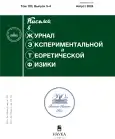On exchange-correlation energy in DFT scenarios
- Авторлар: Belhaj A.1, Ennadifi S.E2
-
Мекемелер:
- ESMaR, Faculty of Sciences, Mohammed V University in Rabat
- LHEP-MS, Faculty of Sciences, Mohammed V University in Rabat
- Шығарылым: Том 120, № 3-4 (2024)
- Беттер: 217-218
- Бөлім: Articles
- URL: https://journals.rcsi.science/0370-274X/article/view/262253
- DOI: https://doi.org/10.31857/S0370274X24080105
- EDN: https://elibrary.ru/DWPJPJ
- ID: 262253
Дәйексөз келтіру
Толық мәтін
Аннотация
Motivated by the considerable importance of material properties in modern condensed matter physics research, and using techniques of the Ne-electron systems in terms of the electron density nσe (r) needed to obtain the ground-state energy Ee0 in Density Functional theory scenarios, we approach the exchange-correlation energy Exc [nσe(r)] by considering the interelectronic position corrections Δr↑↑,↑↓ x = |δr↑↑ − δr↑↓| and Δr eiej6≠i c = λc |r − r′|−(Ne−1)−1 corresponding to the spin and the Coulomb correlation effects, respectively, through the electron-electron potential energy. Exploiting such corrections, we get approximate expressions for the exchange Ex [nσe] and the correlation Ec [nσe] functional energies which could be interpreted in terms of magnetic and electric dipole potential energies associated with the charge density nσe (r) described by inversesquare potential behaviors. Based on these arguments, we expect that such obtained exchange-correlation functional energy could be considered in the Local Density Approximation functional as an extension to frame such interelectronic effects.
Авторлар туралы
A. Belhaj
ESMaR, Faculty of Sciences, Mohammed V University in Rabat
Хат алмасуға жауапты Автор.
Email: ennadifs@gmail.com
Rabat, Morocco
S. Ennadifi
LHEP-MS, Faculty of Sciences, Mohammed V University in Rabat
Email: ennadifs@gmail.com
Rabat, Morocco
Әдебиет тізімі
- D.R. Hartree, TheWave Mechanics of an Atom with a Non-Coulomb Central Field, Part Theory and Methods. Mathematical Proceedings of the Cambridge Physical Society 24, 89 (1928).
- V. Fock, Zeitschrift f¨ur Physik 61, 126 (1930).
- J.C. Slater, Phys. Rev. 81(3), 385 (1951).
- L.H. Thomas, Mathematical Proceedings of the Cambridge Philosophical Society 23(5), 542 (1927).
- F. Enrico, Rend. Accad. Naz. Lincei. 6, 602 (1927).
- W. Kohn and L. J. Sham, Phys. Rev. 140(4A), 1133 (1965).
- P. Hohenberg and W. Kohn, Phys. Rev. B 136, 864 (1964).
- M. Born and R. Oppenheimer, Ann. Physik 84, 457(1927).
- D. Bouaziz and T. Birkandan, Ann. Phys. (NY) 387, 62 (2017).
- C.A. de Lima Ribeiro, C. Furtado, and F. Moraes, Mod. Phys. Lett. A 20, 1991 (2005).
- M. Sreelakshmi and R. Akhilesh, J. Phys. G: Nucl. Part. Phys. 50, 073001 (2023).
- H.E. Camblong and C.R. Ordonez, Phys. Rev. D 68, 125013 (2003).
- T. Jenke, G. Cronenberg, J. Burgd¨orfer, L.A. Chizhova, P. Geltenbort, A.N. Ivanov, T. Lauer, T. Lins, S. Rotter, H. Saul, U. Schmidt, and H. Abele, Phys. Rev. Lett. 112, 151105 (2014).
- D. Bagayoko, AIP Advances. 4(12), 127104 (2014).
- A.D. Becke, J. Chem. Phys. 104, 1040 (1996).
Қосымша файлдар









